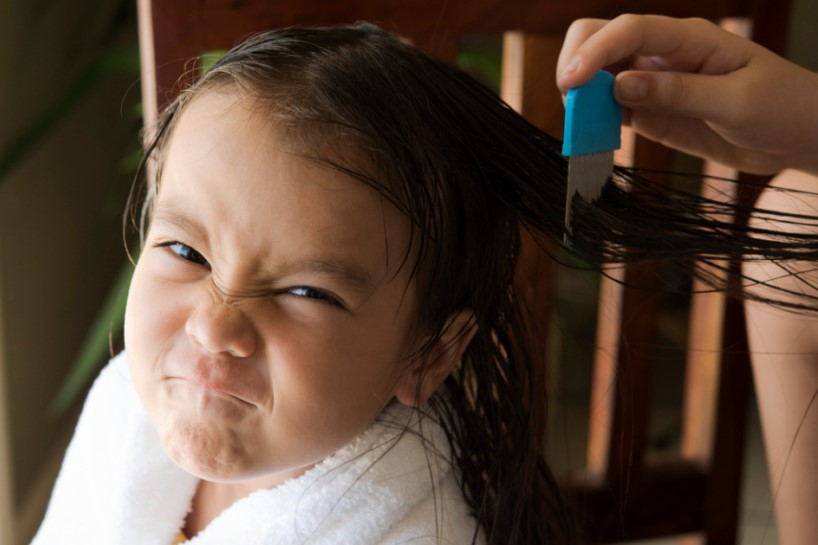
Let's talk about lice: what is pediculosis?
When we talk about ‘pediculosis’ we are referring to a rather common infestation of lice, small parasites recognisable by their white-grey colour that live in human hair and hairs, feeding on blood
Pediculosis: how to recognise infestation
Head lice are rather small, ranging from one to three mm in size.
Thanks to their little legs equipped with hooks, they are able to move nimbly on their favourite terrain: the scalp.
In this environment, lice proliferate.
The females hatch, grow, feed and lay eggs known as ‘nits’ – recognisable by their small size (1 mm), slightly elongated and white in colour – making them firmly adhere to the hair shaft or hair.
The eggs have a maturation period of about 7 days and – in the course of a month – lice can produce between 80 and 300 eggs.
Recognising that there is an infestation in progress is simple.
This manifests itself through irritation, itching and redness, which can lead to dermatitis, impetigo and other similar skin diseases.
Types of louse
There are three different species of louse
Head louse (pediculus capitis)
This is by far the most common louse.
It is usually found on the head of children and particularly in the nape of the neck and behind the ear.
The insect has hooked legs, which anchor themselves in the hair.
Body louse (pediculus humanus)
Now uncommon, it is practically indistinguishable from the head louse.
Unlike the head louse, the body louse does not lay its eggs on the host, but in clothing and fabrics that are in contact with the body.
Pubic louse (phthirus pubis)
Commonly known as the ‘crab louse’, it has a more flattened appearance than the previous ones.
It is equipped with very robust limbs and hooks, capable of anchoring itself to hairs stronger than hair.
It is transmitted by intimate contact, especially in adults.
Pediculosis: subjects at risk
Those most affected by lice infestation, especially head lice, are children between 3 and 11 years of age.
These easily transmit pediculosis to their families, as transmission occurs through direct contact with persons already infested or through the exchange of clothing or personal effects, such as pillows, hats, scarves or combs.
Girls are more susceptible to contracting pediculosis, due – generally – to their long, thick hair.
Body lice, on the other hand, usually infest individuals living in crowded conditions with poor hygiene.
Body lice live on clothing and bed linen that are in contact with the skin, not directly on people, and spread through the sharing of such contaminated clothing.
Unlike head lice, body lice sometimes transmit serious epidemic diseases, such as exanthematous typhus, recurrent fever and trench fever.
Pediculosis: treatment
When lice infestation is detected on the scalp, the use of insecticidal products to eradicate the parasites becomes necessary.
These products are available at normal pharmacies and are easily found in the form of lotions, sprays or powders to be spread on the scalp.
During the treatment, the use of a fine-toothed comb is recommended so that the now dead parasites and their eggs can be easily removed.
Generally, it will be necessary to repeat the insecticide treatment at least twice, the second time 7 to 10 days after the first, to kill the lice hatched from the eggs after the first treatment.
If the infestation concerns the pubis, the area must be completely shaved and the same insecticidal products used to treat scalp infestation must be used – with due caution, given the sensitive area.
Pediculosis of the body is now very rare but – should it occur – the subject must wash carefully with water and specific insecticide and wash clothes (old and new) with boiling water and the same insecticide.
Pediculosis: how to prevent it
Prevention of pediculosis – especially among children – is done by teaching them the most normal and healthy hygienic habits: habitually changing clothes, avoiding sharing combs, brushes, hair accessories, scarves and hats.
In adults, it is advisable to maintain responsible sexual behaviour, as this is the major vehicle of transmission of pediculosis.
Read Also
Emergency Live Even More…Live: Download The New Free App Of Your Newspaper For IOS And Android
Head Lice And Ticks: How To Remove Them
How To Protect Yourself From The Bite Of The Violin Spider (Or Brown Recluse)?
What Is Lyme Disease And What Are Its Symptoms?
Lyme Disease: Watch Out For Tick Bites


